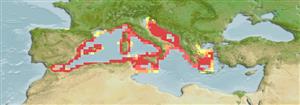Common names from other countries
Environment: milieu / climate zone / depth range / distribution range
Écologie
; profondeur 8 - 200 m (Ref. 1695). Subtropical; 46°N - 35°N, 6°W - 26°E (Ref. 1695)
Distribution
Pays | Zones FAO | Écosystèmes | Occurrences | Introductions
Mediterranean Sea.
Length at first maturity / Taille / Poids / Âge
Maturity: Lm ? range ? - ? cm Max length : 2.6 cm ML mâle / non sexé; (Ref. 1695); 2.8 cm ML (female)
Found mainly on muddy bottoms between 60 and 200 m depth throughout its distributional range. A preference for shallower, coastal and sandy bottoms have been observed in the Adriatic and Tyrrhenian Seas where it can be very abundant and often associated with Turritella communis, Astropecten bispinosus,and Ophiura texturata. Spawning period possibly prolonged based on the observation of mature individuals present throughout the year. Adults have been collected in midwater during night purse seine fishing for blue fishes, evidence of its strong swimming ability. Collected by local small-scale fisheries throughout its distributional range (Ref. 1695).
Life cycle and mating behavior
Maturité | Reproduction | Frai | Œufs | Fécondité | Larves
Members of the class Cephalopoda are gonochoric. Male and female adults usually die shortly after spawning and brooding, respectively. Mating behavior: Males perform various displays to attract potential females for copulation. During copulation, male grasp the female and inserts the hectocotylus into the female's mantle cavity where fertilization usually occurs. Life cycle: Embryos hatch into planktonic stage and live for some time before they grow larger and take up a benthic existence as adults.
Jereb, P. and C.F.E. Roper (eds.). 2005. (Ref. 1695)
Statut dans la liste rouge de l'IUCN (Ref. 130435)
statut CITES (Ref. 108899)
Not Evaluated
Not Evaluated
Utilisations par l'homme
| FishSource |
Outils
Plus d'informations
Taille/ÂgeCroissanceLongueur-poidsLongueur-longueurMorphologieLarvesAbondance
Sources Internet
Estimates based on models
Preferred temperature
(Ref.
115969): 13.3 - 17.1, mean 14.5 (based on 83 cells).
Vulnérabilité
Low vulnerability (10 of 100).
Catégorie de prix
Unknown.
